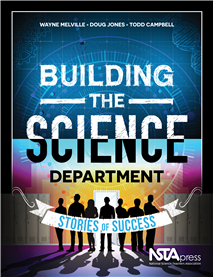Build the Science Department: Stories of Success
By Carole Hayward
Posted on 2017-11-26
 How can your science department become a site for developing teachers’ professional learning?
How can your science department become a site for developing teachers’ professional learning?
Building the Science Department: Stories of Success by Wayne Melville, Doug Jones, and Todd Campbell, features authentic accounts of teachers invested in reforming science teaching and learning. From the authors of the NSTA Press guide Reimagining the Science Department, this book offers stories told in teachers’ own words to provide advice and insight into strategies for building and improving a science department.
The book was conceived with the intention of sharing the stories of teachers who had negotiated reforms, challenged their own teaching practices, changed their classrooms, and transformed their departments.
The first part of the book focuses on scientific activity as represented in A Framework for K–12 Science Education and the Next Generation Science Standards (NGSS), and looks at how scientific activity can be used to “frame the work within science departments and how it aligns with contemporary visions of science teaching and learning.”
The second part of the book features teacher vignettes that address the various parts of a professional learning framework: context, content, activities, and processes. Each vignette is accompanied by commentary that unpacks key points and messages, and includes questions designed to challenge teachers to improve their instructional practices and align these practices more closely with current reform initiatives. As the authors note, one teacher alone cannot achieve the vision and aim of the Framework and NGSS; instead, teachers must work together as a department to collaborate, learn together, and move the department forward as a unit.
The book discusses some of the cultural issues that serve to maintain the status quo in science teaching. “The current reality is that school science has not changed much in the past century and is struggling to engage and retain students in many parts of the Western world,” the authors state.
Traditionally-taught school science, rather than engage young people, turns them away from the field; therefore, in order to reform science education, deeper and more authentic professional learning will be required. What’s being offered to teachers now isn’t good enough. “If we are being honest, the value of much professional learning that occurs in schools can be questioned. The reason for this pessimistic view is that much professional learning fails to address teachers’ learning needs, the context of their work, or the ways in which adults learn,” the authors state.
By exploring real-life examples from both new and veteran teachers, Building the Science Department can help science teachers identify gaps in their knowledge and experience, and start to build departments that will be able to meet the needs of diverse teachers interested in creating curricula and teaching practices that will engage their students and help them to achieve.
To learn more, read the sample chapter “The Content of Professional Learning.”
This book is also available as an e-book.
Follow NSTA
Disclaimer: The views expressed in this blog post are those of the author(s) and do not necessarily reflect the official position of the National Science Teaching Association (NSTA).


